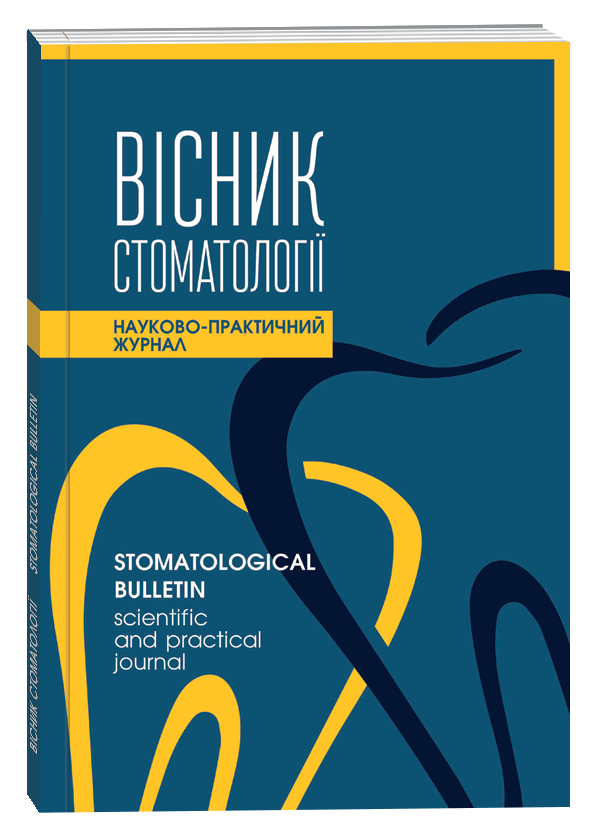ANALYSIS OF THE RESULTS OF THE APPLICATION OF NEW TIRE DESIGNS IN THE FRONTAL SECTION OF MODERN REINFORCING MATERIALS IN PATIENTS WITH DEFECTS IN THE LATERAL SECTION OF THE TOOTH HAVING GENERALIZED PERIODONTITIS IN THE STAGE OF DENSITOMETRY STABILIZATION
DOI:
https://doi.org/10.35220/2078-8916-2019-33-3-43-46Keywords:
generalized periodontitis in the stage of stabi-lization, densitometric parameters, dental splintingAbstract
Topicality. Periodontal pathology occupies a large per-centage of dental diseases, which encourages dentists and scientists to more actively engage in this problem. perio-dontitis in the stage of stabilization.
For the treatment of generalized periodontitis by the or-thopedic component, we have proposed the claimed inter-dental tires, which were used in the orthopedic treatment of patients with this pathology in addition to the tradi-tional ones. Defects in the lateral areas were not encir-cled by bridged structures. Objective. To find out clinically which of the tires used in the study are more physiological for provoked periodon-tal surgery in the area of their responsibility using densi-tometry. Materials and Methods. This clinical study was conduct-ed in a group of 60 patients with generalized periodontitis undergoing stabilization. Previously, they had undergone comprehensive treatment for generalized periodontitis. In the study group with periodontal condition in the stage of stabilization were 30 people - the group with the declared tested tires. And the group with the famous traditional tires - 30 people in the group. Results. The study found that after 18 months the value of densitometry in patients with defects in the dentition where the tires and bridges were used in the control group increased, on average, by 29.1 ± 0.9 %, and in the study group - only by 9.3 ± 0.4 % (p <0.001). During the whole study period in the group with defects in the dentition, where the tires and bridging orthopedic structures were used, the dynamics of development of bone density reduction in the study group was more re-strained compared to the control. The percentage im-provement was 18.8 ± 1.0 % in 18 months. Conclusions: Studies in groups of patients with defects in the lateral areas revealed an advantage in the use of new suture structures when applied in the frontal area with generalized periodontitis in the stage of stabilization be-fore traditional splinting on the basis of performed densi-tometry.
References
Борисенко А.В. Заболевания пародонта / Бори-сенко А. В. – К.: «Медицина», 2013. – 456 с. 2. Грудянов А.И. Заболевания пародонта / Грудянов А.И. – М.: «МИА», 2009. – 336 с. 3. Грудянов А.И. Планирование лечебных меро-приятий при заболеваниях пародонта / А.И. Грудянов, И.Ю. Александровская. – М: «МИА». – 2010. – 56 с. 4. Данилевский Н.Ф. Заболевания пародонта / Н.Ф. Данилевский, А.В. Борисенко. – К.: Здоров'я, 2000. – 462 с. 5. Ковалевский А.М. Лечение пародонтита / Кова-левский А.М. – М.: «МИА», 2010. – 160 с. 6. Копейкин В.Н. Ортопедическое лечение заболе-ваний пародонта / Копейкин В. Н. – М.:«Триада-Х», 1998. – 176 с. 7. Іщенко П.В. Зубна шина / Іщенко П.В., Кльомін В.А. Деклараційний патент на корисну модель U200910547 № 49996 А61С8/02, заявлено 19.10.2009, опубліковано 25.05.2010. Бюл. № 10.
Іщенко П.В. Зубна шина / Іщенко П.В., Кльомін В.А., Гаврилов О.Є. Деклараційний патент на корисну мо-дель U200910584 № 49999 А61С8/02, заявлено 19.10.2009, опубліковано 25.05.2010. Бюл. № 10.









